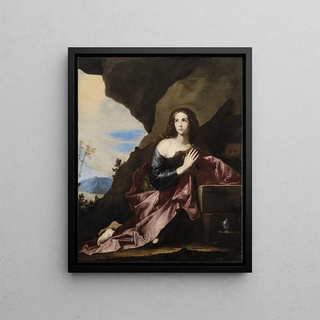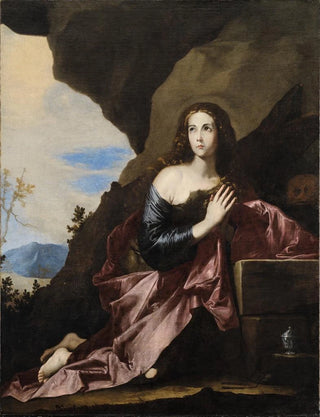Art print | Penitent Mary Magdalene - Jusepe de Ribera


View from behind

Frame (optional)
Marie Madeleine pénitente - Jusepe de Ribera – Engaging Introduction
In the captivating world of baroque art, the artwork "Marie Madeleine pénitente" by Jusepe de Ribera stands out for its emotional depth and visual power. This painting, created in the 17th century, depicts an iconic figure of repentance and Christian spirituality. The artist, through his interpretation of Marie Madeleine, manages to capture not only the physical beauty of his model but also the complexity of her troubled soul. The painting is an invitation to delve into the intimacy of penitence, offering a reflection on suffering and redemption that still resonates today.
Style and uniqueness of the work
Ribera's work is characterized by a bold style and an unparalleled mastery of light and shadow. In "Marie Madeleine pénitente," the artist uses dramatic lighting to highlight Marie's facial features, thus emphasizing her expression of pain and meditation. The dark colors, typical of Caravaggism, envelop the scene in an atmosphere of mystery and gravity. The texture of the clothing, rendered with remarkable precision, adds a tactile dimension to the painting, while Marie's intense gaze seems to pierce the viewer, creating a powerful emotional connection. Ribera does not merely depict a religious figure; he transforms her into a symbol of inner struggle, inviting everyone to reflect on their own quest for redemption.
The artist and his influence
Jusepe de Ribera, often nicknamed "Lo Spagnoletto," is one of the major figures of Spanish baroque. Trained in Italy, he mastered the influences of Caravaggio and Renaissance masters, while developing a style that is uniquely his own. His ability to portray human suffering with such intensity profoundly marked his contemporaries and influenced many artists across the centuries. Ribera brought to life biblical and mythological characters with rare authenticity, making his works reflections on the human condition. "Marie Madeleine pénitente" is a perfect example of this approach, where spirituality and humanity meet in a scene that is both intimate and universal.

Matte finish

View from behind

Frame (optional)
Marie Madeleine pénitente - Jusepe de Ribera – Engaging Introduction
In the captivating world of baroque art, the artwork "Marie Madeleine pénitente" by Jusepe de Ribera stands out for its emotional depth and visual power. This painting, created in the 17th century, depicts an iconic figure of repentance and Christian spirituality. The artist, through his interpretation of Marie Madeleine, manages to capture not only the physical beauty of his model but also the complexity of her troubled soul. The painting is an invitation to delve into the intimacy of penitence, offering a reflection on suffering and redemption that still resonates today.
Style and uniqueness of the work
Ribera's work is characterized by a bold style and an unparalleled mastery of light and shadow. In "Marie Madeleine pénitente," the artist uses dramatic lighting to highlight Marie's facial features, thus emphasizing her expression of pain and meditation. The dark colors, typical of Caravaggism, envelop the scene in an atmosphere of mystery and gravity. The texture of the clothing, rendered with remarkable precision, adds a tactile dimension to the painting, while Marie's intense gaze seems to pierce the viewer, creating a powerful emotional connection. Ribera does not merely depict a religious figure; he transforms her into a symbol of inner struggle, inviting everyone to reflect on their own quest for redemption.
The artist and his influence
Jusepe de Ribera, often nicknamed "Lo Spagnoletto," is one of the major figures of Spanish baroque. Trained in Italy, he mastered the influences of Caravaggio and Renaissance masters, while developing a style that is uniquely his own. His ability to portray human suffering with such intensity profoundly marked his contemporaries and influenced many artists across the centuries. Ribera brought to life biblical and mythological characters with rare authenticity, making his works reflections on the human condition. "Marie Madeleine pénitente" is a perfect example of this approach, where spirituality and humanity meet in a scene that is both intimate and universal.






